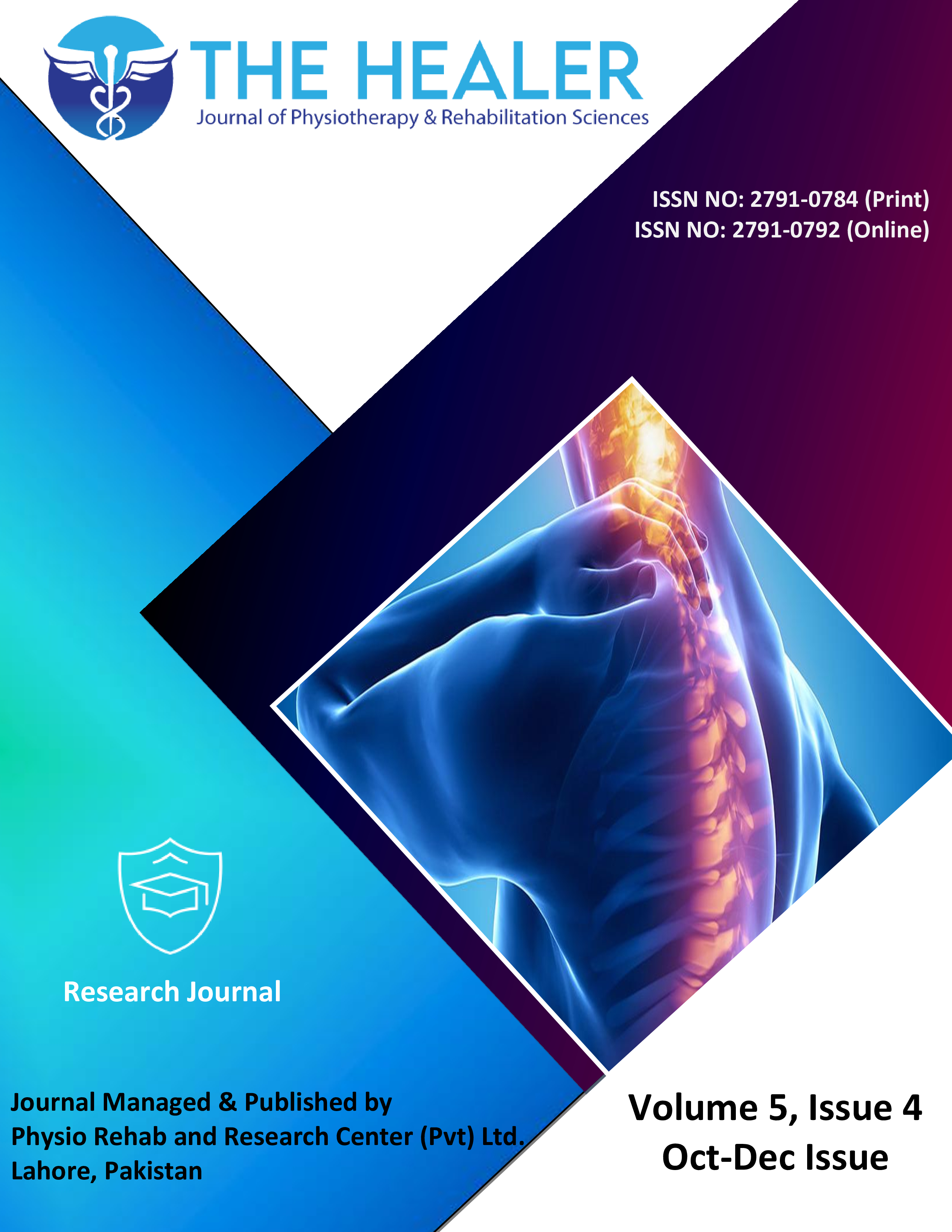Impact of Carry Angle Variation on Shoulder Joint Stability and Risk of Shoulder Injury in Fast Bowlers
DOI:
https://doi.org/10.55735/4t03xx80Keywords:
Carrying angle, Fast bowlers, Shoulder injury, Shoulder joint stability, Upper limb alignmentAbstract
Background: Fast bowling involves repetitive high-velocity arm motions that place significant biomechanical stress on the shoulder. Shoulder injuries in fast bowlers often result from instability, overuse, and poor kinetic mechanics. The carry angle between the humerus and ulna affects upper limb alignment, and abnormal variations may disrupt force transmission, compromising shoulder stability and increasing injury risk. Objective: To determine the impact of carry angle variation on shoulder joint stability and the risk of shoulder injury among fast bowlers. Methodology: A cross-sectional analytical study was conducted at Peshawar Sports Complex on 80 male fast bowlers aged 18 to 30 years with at least two years of competitive experience. The carry angle was measured using a goniometer, and shoulder stability was evaluated through the Oxford Shoulder Instability Score and clinical tests. Shoulder injuries were recorded using the OSICS-10 questionnaire. Data were analyzed in SPSS 25 using Pearson’s correlation, independent t-test, and logistic regression, with p ≤ 0.05 considered significant. Intra-rater reliability was established through pilot testing on ten participants, yielding an intraclass correlation coefficient (ICC) of 0.91, confirming the reliability of both goniometric and questionnaire-based assessments. Results: The mean dominant-arm carrying angle was 11.2±2.1°, significantly higher than the non-dominant arm (8.6±1.8°, p<0.00). A negative correlation existed between carrying angle and shoulder stability (r=−0.52, p<0.01), while a positive correlation was found between carrying angle and shoulder injury occurrence (r=0.47, p<0.01). Bowlers with a carrying angle greater than 12° had significantly reduced stability scores (32.4±5.6) and higher injury rates (58.6%) than those with normal angles (40.8±4.9, 31.4%, p=0.01). Logistic regression revealed that each 1° increase in carrying angle predicted a 0.43-point decrease in shoulder stability (β=−0.43, p=0.00) and a 12% higher injury risk (OR=1.12, 95% CI: 1.04–1.24, p=0.00). Conclusion: An increased carrying angle significantly reduced shoulder joint stability and increased the risk of shoulder injury among fast bowlers. Routine biomechanical screening and corrective training should be incorporated in cricket conditioning programs to minimize shoulder injuries linked with excessive carrying angles.
Downloads
References
1. Mansingh A. Shoulder injuries in modern cricket: Should an increase be anticipated? Indian Journal of Orthopaedics. 2023; 57(10), 1561–64.
https://doi.org/10.1007/s43465-023-00963-x
2. Bauer J, Schedler S, Fischer S, Muehlbauer T. Relationship between upper quarter y-balance test performance and throwing proficiency in adolescent Olympic handball players. BMC Sports Science, Medicine and Rehabilitation. 2020; 12: 50.
https://doi.org/10.1186/s13102-020-00199-4
3. Bauer J, Panzer S, Gruber M, Muehlbauer T. Associations between upper quarter y-balance test performance and sport-related injuries in adolescent handball players. Frontiers in Sports and Active Living. 2023; 5: 1076373.
https://doi.org/10.3389/fspor.2023.1076373
4. Venturin D, Giannotta G, Pellicciari L, et al. Reliability and validity of the shoulder pain and disability index in a sample of patients with frozen shoulder. BMC Musculoskeletal Disorders. 2023; 24(1): 212.
https://doi.org/10.1186/s12891-023-06268-2
5. Nayak S, Kumar P, Oraon A K. Relationship of carrying angle with grip strength and anthropometric measurements in young adults. Bulletin of Faculty of Physical Therapy. 2023; 28(1): 16.
https://doi.org/10.1186/s43161-023-00129-8
6. Kiatkulanusorn S, Luangpon N, Srijunto W, et al. Analysis of the concurrent validity and reliability of five common clinical goniometric devices. Scientific Reports. 2023; 13: 20931.
https://doi.org/10.1038/s41598-023-48344-6
7. Felton PJ, McCaig S, King MA. Cricket fast bowling: The relationship between range of motion and key performance and injury technique characteristics. Journal of Sports Sciences. 2023; 41(2): 112–120.
https://doi.org/10.1080/02640414.2023.2200520
8. Bauer J, Panzer S, Muehlbauer T. Side differences of upper quarter Y balance test performance in sub-elite young male and female handball players with different ages. BMC Sports Science, Medicine and Rehabilitation. 2021; 13(1): 141.
https://doi.org/10.1186/s13102-021-00364-3
9. Stevens KJ. Valgus Extension Overload of the Elbow in Overhead Throwing Athletes. Journal of the Korean Society of Radiology. 2025; 86(5): 704–19.
https://doi.org/10.3348/jksr.2025.0050
10. Shah SS, Goldstein JA, Stein S, et al. Increased valgus carrying angle at the elbow correlates with shoulder and elbow injuries in professional pitchers: a prospective study. Orthopaedic Journal of Sports Medicine. 2017; 5(7 suppl6): 2325967117S00379.
https://doi.org/10.1177/2325967117S00379
11. Gorman PP, Butler RJ, Plisky PJ, Kiesel KB. Upper quarter y balance test: reliability and performance comparison between genders in active adults. Journal of Strength and Conditioning Research. 2012; 26(11): 3043–48.
https://doi.org/10.1519/JSC.0b013e3182472fdb
12. Ravi B, Kapoor M, Player D. Feasibility and reliability of a web-based smartphone application for joint position measurement. Journal of Rehabilitation Medicine. 2021; 53(5): jrm00188. https://doi.org/10.2340/16501977-2780
13. Maryam S, Malhotra D, Khan SA, Singla D, Zaidi S. Shoulder rotator muscle imbalance in collegiate cricket bowlers: Measurement by Isokinetic Dynamometer at different angular velocities. Measurement: Sensors. 2022; 24: 100556.
https://doi.org/10.1016/j.measen.2022.100556
14. Nimse A, Patel N, Pardiwala D. Criterion-based rehabilitation and return to play in fast bowlers following arthroscopic Bankart repair: recommendations based on a detailed clinical review. Indian Journal of Orthopaedics. 2023; 57(10): 1565–74.
https://doi.org/10.1007/s43465-023-00931-5
15. Zondo S, Abdullahi Y, Noorbhai H. Highlighting rural cricket: Prevalence, aetiology, and risk factors for injury. Open Sports Sciences Journal. 2023; 16(3): 1–8.
https://doi.org/10.2174/1875399X-v16-230627-2023-7
16. Steele C, Valentin S. Intrinsic and extrinsic variables impacting upper quarter Y-balance test scores in sporting cohorts: A systematic review. Journal fof Bodyworks and Movement Therapy. 2024; 39: 183–94.
https://doi.org/10.1016/j.jbmt.2024.02.043
17. Erickson BJ, Chalmers PN, Zajac J, et al. Do professional baseball players with a higher valgus carrying angle have an increased risk of shoulder and elbow injuries? Orthopaedic Journal of Sports Medicine. 2019; 7(8): 2325967119866734.
https://doi.org/10.1177/2325967119866734
18. Khan MS, Singh RB. Variation in carrying angle - A normative study. Indian Journal of Orthopaedics Surgery. 2023; 9(4): 237–42
https://doi.org/10.18231/j.ijos.2023.045
19. Porollan JC, Soliño S, Fabani FJ, et al. Cross-cultural adaptation and psychometric properties of the Argentine version of the shoulder pain and disability index (SPADI) in patients with shoulder disorders. JSES International. 2024; 9(2): 532–41.
https://doi.org/10.1016/j.jseint.2024.11.008
20. Stretch, RA. Cricket injuries: a longitudinal study of the nature of injuries to South African cricketers commentary. British Journal of Sports Medicine. 2003; 37(3): 250–53. https://doi.org/10.1136/bjsm.37.3.250
21. Kc S, Sharma S, Ginn KA, Reed D. Measurement properties of translated versions of the Shoulder Pain and Disability Index: A systematic review. Clinical Rehabilitation. 2021; 35(3): 410–22.
https://doi.org/10.1177/0269215520963199
22. Munir A, Ikram M, Rehman SSU. Urdu translation of the Shoulder Pain and Disability Index (SPADI) and its validity and reliability on adhesive capsulitis patients. BMC Musculoskeletal Disorders. 2022; 23(1): 221.
https://doi.org/10.1186/s12891-022-05182-3
23. Brindisino F, Venturin D, Bartoli M, et al. Psychometric properties of the Disability of Arm Shoulder and Hand (DASH) in subjects with frozen shoulder: a reliability and validity study. BMC Musculoskeletal Disorders. 2024; 25(1): 260.
https://doi.org/10.1186/s12891-024-07371-8
24. Ahmad J, M. Jamshaid M, Ashfaq H. Frequency of shoulder pain among fast and spin cricket bowlers training in Pakistan Sports Board, Lahore. Journal of Health and Rehabilitation Research. 2024; 4(ICIC1).
https://doi.org/10.61919/jhrr.v4iICIC1.1054
25. Worthington PJ, King MA, Ranson C. Relationships between fast bowling technique and ball release speed in cricket. Journal of Applied Biomechanics. 2012; 29(1): 78–84.
https://doi.org/10.1123/jab.29.1.78
26. Yanai K, Tajika T, Hatori Y, et al. Relationship between the carrying angle, medial instability of the elbow, and general joint laxity in high school baseball pitchers: a cross-sectional study. JSES International. 2025; 9(4): 1390–95.
https://doi.org/10.1016/j.jseint.2025.02.023
27. Van Roy P, Baeyens JP, Fauvart D, et al. Arthro-kinematics of the elbow: study of the carrying angle. Ergonomics. 2005; 48(11-14): 1645–56.
https://doi.org/10.1080/00140130500101361
28. Olivier B, Lala B, Gillion N. The cricketer’s shoulder and injury: Asymmetries in range of movement and muscle length. The South African journal of physiotherapy. 2020; 76(1): 754.
https://doi.org/10.4102/sajp.v76i1
29. Dennis RJ, Finch CF, Farhart PJ. Is bowling workload a risk factor for injury to Australian junior cricket fast bowlers? British Journal of Sports Medicine. 2005; 39(11): 843–46.
https://doi.org/10.1136/bjsm.2005.018515
30. Perrett C, Lamb P, Bussey M. Is there an association between external workload and lower-back injuries in cricket fast bowlers? A systematic review. Physical Therapy in Sport. 2020; 41: 71–79.
https://doi.org/10.1016/j.ptsp.2019.11.007
31. Roca M, Elliott B, Alderson J, Foster D. The relationship between shoulder alignment and elbow joint angle in cricket fast-medium bowlers. Journal of Sports Sciences. 2006; 24(11): 1127–35.

Downloads
Published
License
Copyright (c) 2025 The Healer Journal of Physiotherapy and Rehabilitation Sciences

This work is licensed under a Creative Commons Attribution 4.0 International License.














